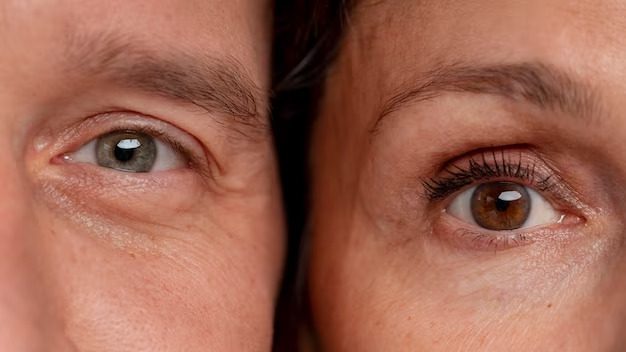
Welcome to our in-depth exploration of lifestyle factors that can hasten the appearance of crow’s feet around your eyes. Crow’s feet, those fine lines, and wrinkles at the corners of your eyes are often associated with aging.
However, did you know that certain lifestyle choices can accelerate their development?
This comprehensive guide delves into the science behind crow’s feet, reveals how daily habits impact their formation, and provide valuable insights on preventing and treating them, including using neuromodulation injections.
The Anatomy of Crow’s Feet
Before we delve into the lifestyle factors, let’s understand the skin structure around our eyes.
The skin in this area is delicate and thin, making it more prone to aging. Collagen and elastin, two crucial proteins, maintain skin elasticity.
As we age, these proteins naturally degrade, leading to the appearance of crow’s feet.
Sun Exposure – UV Rays and Skin Damage
The allure of the sun’s golden rays can be irresistible, but it comes with a price for our skin. UV rays from the sun significantly contribute to premature aging, including forming crow’s feet.
Prolonged sun exposure leads to photoaging, where collagen and elastin fibers break down faster, causing the skin to lose elasticity.
Protecting your skin from the sun’s harmful rays with sunscreen and adopting preventive measures is vital to combat premature aging and crow’s feet.
Neuromodulation therapy can also be an effective option to manage crow’s feet caused by sun exposure.
Smoking and Premature Aging

Beyond the well-known health risks, smoking also significantly impacts skin aging. Harmful chemicals in tobacco smoke constrict blood vessels, reducing oxygen and nutrient supply to the skin.
This results in decreased collagen production, leading to premature wrinkles and, you guessed it, crow’s feet. Quitting smoking benefits your overall health and improves your skin’s appearance.
Diet and Nutrition – Foods for Skin Health
The adage “you are what you eat” concerns your skin health. A diet rich in antioxidants, vitamins (especially A, C, and E), and minerals is essential for promoting healthy skin and reducing wrinkles.
Foods such as berries, leafy greens, and fish provide valuable nutrients that nourish your skin and combat crow’s feet. Conversely, an unhealthy diet high in sugar and processed foods can accelerate crow’s feet formation.
Sleep Patterns – Beauty Rest for Your Skin
Your skin loves a good night’s sleep as much as you do. During deep sleep, your body repairs and regenerates cells, including those responsible for skin health.
Lack of sufficient and quality sleep can disrupt this process, leading to decreased collagen production and increased skin aging, including the development of crow’s feet.
Establishing a consistent sleep routine and prioritizing restful sleep is essential for maintaining youthful-looking skin.
Hydration and Moisture – Your Skin’s Best Friend
Proper hydration is a cornerstone of healthy skin. Dehydration can make your skin look dry, dull, and wrinkled, making crow’s feet more noticeable.
Drinking plenty of water and a hydrating skincare routine can help keep your skin plump, supple, and youthful.
Stress Management – A Calm Approach to Skin Health

Stress is an inevitable part of life, but chronic stress can take a toll on our skin.
Elevated stress hormones can lead to inflammation and oxidative stress, accelerating aging.
Managing stress through relaxation techniques like meditation, yoga, or time in nature can positively impact your skin’s health and reduce the formation of crow’s feet.
Facial Expressions and Habits
Our facial expressions play a role in the formation of crow’s feet. Repetitive facial movements, such as squinting or frowning, can develop fine lines around the eyes.
Being mindful of these expressions and adopting eye exercises or facial yoga can help reduce strain on the eye area and maintain a more youthful appearance.
Prevention and Treatment Options

Prevention is the key to managing crow’s feet effectively. Protect your skin from sun exposure, quit smoking, adopt a healthy diet, prioritize sleep, manage stress, and be mindful of facial expressions.
Consider neuromodulation therapy, botox, fillers, and laser treatments as effective professional options for combating crow’s feet. Additionally, natural remedies and at-home skincare solutions can complement your efforts in maintaining healthy, youthful skin.
Conclusion
Congratulations! You are now armed with comprehensive knowledge of the lifestyle factors contributing to premature crow’s feet formation. By implementing a balanced lifestyle, nourishing your skin, and considering the benefits of neuromodulation therapy, you can take control of your skin health and confidently combat crow’s feet.
For personalized advice and expert guidance, contact Saint Aesthetix today. Their professionals can provide tailored solutions to address crow’s feet and achieve radiant, youthful-looking skin.
Don’t wait any longer to take the first step towards healthier, more beautiful skin. Embrace the journey of aging gracefully and confidently with Saint Aesthetix by your side!


